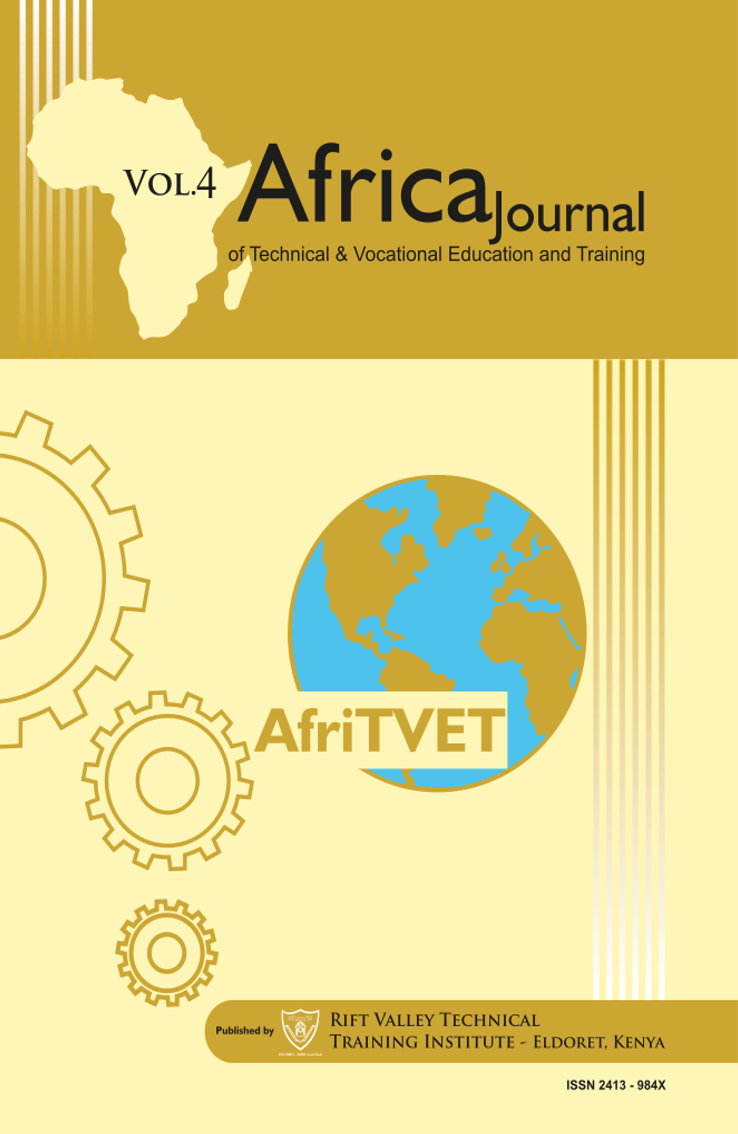Youth Unemployment among Graduates of Tertiary Institutions in Kenya
The Case of Africa Inland Church Jericho
Keywords:
Unemployment, TVET, Life Skills, Lifelong Learning
Abstract
Millions of the youth world over remains unemployed; furthermore, the phenomenon is on the increase. For instance, the projections by countries’ policy makers say youth unemployment is likely to rise by 4 million globally each year. What is more complicated to the policy makers is the high rate of youth unemployment among college graduates. Therefore, graduate unemployment has posed a challenging and complex problem to the leaders, educationists and policy makers at all levels. Even for the few graduates who have managed to secure jobs there is some disquiet among the employers concerning skills deficiency among the recently graduated ones. The issues mentioned by the job market analysts are mismatch and skills oversupply in the market. Based on the simple economic laws of demand and supply, it is catastrophic to over supply labour because a significant number will remain unemployed. Moreover, there is an increment of colleges of higher education globally and each year these colleges are belching out thousands of graduates who throng to the job market. However, more graduates are coming out possessing skills that are seemingly not in demand in the job market. Therefore, a huge gap exists between the skills demanded by the employers, and the skills possessed by the graduates, thus, only those graduates possessing the relevant skills are employable. This paper attempted to investigate tackling of unemployment among college graduates amongst the youth in Kenya; it focused on the youth in Africa Inland Jericho. The objectives of the study were to establish the causes of unemployment among the youth, determine how much the youth know about the skill-driven courses and to demonstrate the programmes that are likely to lead to higher rate of employment. This was a descriptive study where the researcher collected data from 50 respondents sampled from a population of 1,500 church going youths in A.I.C Jericho. The findings showed that 12.5% TVET diploma graduates were unemployed; 93.75 % non-TVET diploma graduates were unemployed, while 80% degree graduates were unemployed. Therefore, the research concluded that lack of skill-driven education among the youth was the greatest cause of unemployment. The study recommended that more emphasis on pursuing skill-based education; more awareness to popularize TVET education because a few of the youth were aware of TVET.Article Views and Downloands Counter
Download data is not yet available.
References
Aryeetey, E., Baah-Boateng W, Ackah C, Mbiti, I. & Lehrer, K. (2014). “Ghana” in Hino & Ranis (ed.) Youth and employment in Sub-Saharan Africa: Working but poor. Routledge Publication, pp. 221-292
Danijel, N. & Tomić, I. (2018). Jobless population and employment flows in recession. Journal of Balkan and Near Eastern Studies, 20:3, 273-292, DOI: 10.1080/19448953.2018.1385271
Farm, A. (2012): Vacancies, labour demand, and unemployment. Swedish Institute for Social Research (SOFI). Stockholm University, SE-106 91 Stockholm, Sweden
Ikharas, I, & Al-Wadi, M. (2016). Economic growth and unemployment relationship: An empirical study for MENA countries. International Journal of Managerial Studies and Research (IJMSR) Volume 4, Issue 12, December 2016, PP 19 http://dx.doi.org/10.20431/2349-0349.0412003
ILO. (2012). Youth unemployment and vocational training. http://dx.doi.org/10.1561/0700000058
ILO. (2014). Global Employment Trends 2011. International Labour Office, Geneva
ILO. (2018). The future of work: A literature review. International Labour Office, Geneva
Linotte, D. (2018). Addressing youth unemployment in the Balkans, with a reference to young carers. Youth Voice Journal, Vol: 8 , Online ISSN: 2056-2969.
King, K. & Palmer, R. (2010). Planning for technical and vocational skills development. Paris. UNESCO International Institute for Educational Planning, 2010. Google Scholar
Kluve, J. (2018). The effectiveness of European active labor market policy (IZA Discussion Paper 2018). Bonn: Institute for the Study of Labor. Google Scholar
Population Reference Bureau. (2013). The World’s Youth: 2013 Data Sheet. www.prb.org
Mayer, T., Moorti, S., Jamie K., & McCallum, J. K. (2018). The crisis of global youth unemployment. Routledge Books, CRC Press.
United Nations. (2012). World youth report. Geneva. United Nations. 2012. Google Scholar
UNESCO. (2010). Reaching the marginalized: Education for all global monitoring report 2010. Paris. UNESCO. Google Scholar
Nason, V. (2017). The role of mentorship as an approach for enhancing employability Skills for 21st Century in Kenya. Africa Journal of Technical and Vocational Education and Training, 2(1), 31-39. Retrieved from http://afritvet.org/index.php/Afritvet/article/view/33
World Bank, (2014). Youth employment in Sub-Saharan Africa. The World Bank, Washington DC.
World Bank. (2016). Bhutan economic update, December 2016. World Bank, Washington, DC.
World Bank. (2018). World Bank development report 2018: Education.Accessed on May 23, www.worldbank.org
WHO. (2016). Health workforce requirements for universal health coverage and the sustainable development goals. Geneva.
Zachary, K., Beblavy, M. & Lenaerts, K. (2018). Blame it on my youth! Policy recommendations for re-evaluating and reducing youth unemployment. Research Report http://aei.pitt.edu/93155/
Danijel, N. & Tomić, I. (2018). Jobless population and employment flows in recession. Journal of Balkan and Near Eastern Studies, 20:3, 273-292, DOI: 10.1080/19448953.2018.1385271
Farm, A. (2012): Vacancies, labour demand, and unemployment. Swedish Institute for Social Research (SOFI). Stockholm University, SE-106 91 Stockholm, Sweden
Ikharas, I, & Al-Wadi, M. (2016). Economic growth and unemployment relationship: An empirical study for MENA countries. International Journal of Managerial Studies and Research (IJMSR) Volume 4, Issue 12, December 2016, PP 19 http://dx.doi.org/10.20431/2349-0349.0412003
ILO. (2012). Youth unemployment and vocational training. http://dx.doi.org/10.1561/0700000058
ILO. (2014). Global Employment Trends 2011. International Labour Office, Geneva
ILO. (2018). The future of work: A literature review. International Labour Office, Geneva
Linotte, D. (2018). Addressing youth unemployment in the Balkans, with a reference to young carers. Youth Voice Journal, Vol: 8 , Online ISSN: 2056-2969.
King, K. & Palmer, R. (2010). Planning for technical and vocational skills development. Paris. UNESCO International Institute for Educational Planning, 2010. Google Scholar
Kluve, J. (2018). The effectiveness of European active labor market policy (IZA Discussion Paper 2018). Bonn: Institute for the Study of Labor. Google Scholar
Population Reference Bureau. (2013). The World’s Youth: 2013 Data Sheet. www.prb.org
Mayer, T., Moorti, S., Jamie K., & McCallum, J. K. (2018). The crisis of global youth unemployment. Routledge Books, CRC Press.
United Nations. (2012). World youth report. Geneva. United Nations. 2012. Google Scholar
UNESCO. (2010). Reaching the marginalized: Education for all global monitoring report 2010. Paris. UNESCO. Google Scholar
Nason, V. (2017). The role of mentorship as an approach for enhancing employability Skills for 21st Century in Kenya. Africa Journal of Technical and Vocational Education and Training, 2(1), 31-39. Retrieved from http://afritvet.org/index.php/Afritvet/article/view/33
World Bank, (2014). Youth employment in Sub-Saharan Africa. The World Bank, Washington DC.
World Bank. (2016). Bhutan economic update, December 2016. World Bank, Washington, DC.
World Bank. (2018). World Bank development report 2018: Education.Accessed on May 23, www.worldbank.org
WHO. (2016). Health workforce requirements for universal health coverage and the sustainable development goals. Geneva.
Zachary, K., Beblavy, M. & Lenaerts, K. (2018). Blame it on my youth! Policy recommendations for re-evaluating and reducing youth unemployment. Research Report http://aei.pitt.edu/93155/
Published
2019-10-24
How to Cite
Nason, B. (2019). Youth Unemployment among Graduates of Tertiary Institutions in Kenya. Africa Journal of Technical and Vocational Education and Training, 4(1), 84-93. Retrieved from https://afritvet.org/index.php/Afritvet/article/view/84
Section
TVET IN ENHANCING SUSTAINABLE DEVELOPMENT
Copyright (c) 2019 Africa Journal of Technical and Vocational Education and Training

This work is licensed under a Creative Commons Attribution-NonCommercial-ShareAlike 4.0 International License.
Copyright Notice Copyright of published articles is held by AfriTVET. No limitation will be placed on the personal freedom of authors to copy or to use in subsequent work, material contained in their papers. Please contact the Publisher for clarification if you are unsure of the use of copyright material. Apart from fair dealing for the purposes of research and private study, or criticism and or review, this publication may only be reproduced, stored or transmitted, in any form or by any means, with the prior permission in writing of the Publishers.


